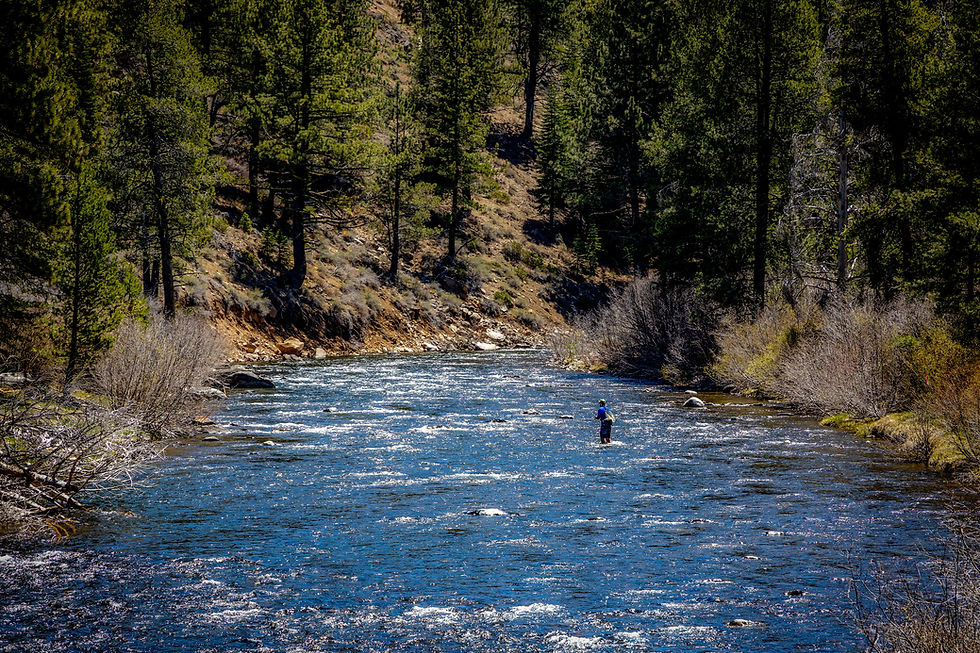Truckee
- Mike Sexton

- Sep 9, 2023
- 3 min read
Updated: Sep 9

This past summer, my wife and I met my folks in Truckee, California. They hadn’t seen my two-year-old son in a while, and the timing worked. At first, the plan struck me as a little random—I’d always thought of Truckee as a winter town. I grew up in Northern California, and the Tahoe basin is where I learned to ski and snowboard in the ’80s. Summer in Truckee had never crossed my mind. Then the angler in me woke up. Of course—6,000 to 8,000 feet, alpine air, rivers brimming with trout.
I had to balance family time with fishing, so my chance to scout the Truckee River was last minute. Mid-August brought warm days in the 80s and scattered showers—ideal conditions for hatches. I didn’t have time to explore the lower canyon stretch toward Reno, where the highway shadows the river, but even the drive in from the Reno airport reminded me of the Gunnison Gorge back in Colorado: rugged, dramatic, and very fishy.
My first morning, I grabbed the rental car and headed into town. The fly shop didn’t open until eight, but conveniently, it was next door to a coffee shop. I figured I’d caffeinate and wait. Bad idea.
Coffee, when it isn’t mine, hits hard. Friends joke about “Mike’s coffee”—so strong it either sends them sprinting to the bathroom or climbing out of their skin. I drink it daily and call it “evening out.” Truthfully, it probably makes me unbearable, and my wife deserves sainthood. The shop’s coffee had me sweating through my fleece and twitching at my watch, second hand loud as a metronome. I tried to calm down by counting breaths—combat breathing, I’d heard it called—but eventually found myself gnawing the plastic lid of my to-go cup. Time to step outside before someone called security.
When I returned, the fly shop was open. Trout Creek Outfitters. Miles, the co-owner, greeted me like an old friend and happily shared intel on the river. He showed me the current flies working, and when I told him I tie my own, he didn’t scoff—unlike a couple of shops I could name, where the staff retreat to folding T-shirts the moment you say you don’t need flies. By the time we wrapped up, I walked out with a bag full of gear, including a waterproof map of the Truckee. That map now hangs in my office.
I settled on a stretch upriver from town, between Truckee and the ski resort once known as Squaw Valley. My plan was a two-mile walk, with a campground as my takeout. I climbed down the bank and slipped into the water just above a flat, at the base of a mid-sized run. Nothing was rising yet, so I tied on a pheasant tail with a zebra midge trailer—my go-to nymph rig.
On the second cast, the indicator twitched, paused, then vanished. Fish on. A clean, strong rainbow. My first Truckee trout. I let out a whoop and laughed to myself. Even if it was the only fish of the day, the trip was already a success.
I worked the run from the far side, picking apart seams and finding three more fish before the river changed tempo. A hatch was starting—gray drakes. I crawled up onto the bank to watch. Nothing was rising upstream, but down on the flats, heads began to poke through the surface, sipping and gulping.
From where I stood, it was too deep to wade closer. I managed to get drakes across and drifted them downstream about twenty feet before drag set in. That trick produced two smaller bows before the pod slid even further downriver.
I circled around, bushwhacked through willows, and found a faint trail leading to the lower end of the pool. Along the way, I passed a makeshift camp littered with fresh trash—a sobering reminder of who else shares the river corridor. It gave me the heebie-jeebies, but I pushed on.
When I got back to the water, the hatch was still thick. The fish hammered my gray drakes until the flies looked ragged. I tried to switch patterns—elk hair with a gnat, a Humpy, nothing fooled them. This was top-shelf selective feeding. Finally, I used an Elk Hair as a marker and trailed what was left of my best battered drake. That bought me one more fish before my supply was gone. I hated to leave feeding trout behind, but I was out of ammo.
I wandered upriver, where the water broke into boulders and pocket water. The landscape opened up—pines, granite, late-summer light slanting across the current. I recognized plants I’d grown up with, and yet everything felt new. Standing midstream, rod in hand, I felt something I hadn’t in years: pride, belonging, connection. In that moment, California didn’t feel like the complicated state I’d left behind. It felt like home.
Fish on.



Comments